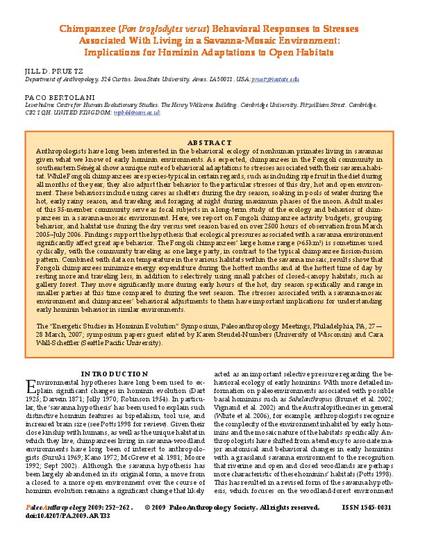
Article
Chimpanzee (Pan troglodytes verus) Behavioral Responses to Stresses Associated With Living in a Savanna-Mosaic Environment: Implications for Hominin Adaptations to Open Habitats
PaleoAnthropology
Document Type
Article
Disciplines
Publication Date
1-1-2009
DOI
10.4207/PA.2009.ART33
Abstract
Anthropologists have long been interested in the behavioral ecology of nonhuman primates living in savannas given what we know of early hominin environments. As expected, chimpanzees in the Fongoli community in southeastern Sénégal show a unique suite of behavioral adaptations to stresses associated with their savanna habitat. While Fongoli chimpanzees are species-typical in certain regards, such as including ripe fruit in the diet during all months of the year, they also adjust their behavior to the particular stresses of this dry, hot and open environment. These behaviors include using caves as shelters during the dry season, soaking in pools of water during the hot, early rainy season, and traveling and foraging at night during maximum phases of the moon. Adult males of this 35-member community serve as focal subjects in a long-term study of the ecology and behavior of chimpanzees in a savanna-mosaic environment. Here, we report on Fongoli chimpanzee activity budgets, grouping behavior, and habitat use during the dry versus wet season based on over 2500 hours of observation from March 2005–July 2006. Findings support the hypothesis that ecological pressures associated with a savanna environment significantly affect great ape behavior. The Fongoli chimpanzees’ large home range (>65km²) is sometimes used cyclically, with the community traveling as one large party, in contrast to the typical chimpanzee fission-fusion pattern. Combined with data on temperature in the various habitats within the savanna mosaic, results show that Fongoli chimpanzees minimize energy expenditure during the hottest months and at the hottest time of day by resting more and traveling less, in addition to selectively using small patches of closed-canopy habitats, such as gallery forest. They move significantly more during early hours of the hot, dry season specifically and range in smaller parties at this time compared to during the wet season. The stresses associated with a savanna-mosaic environment and chimpanzees’ behavioral adjustments to them have important implications for understanding early hominin behavior in similar environments.
Copyright Owner
PaleoAnthropology Society
Copyright Date
2009
Language
en
File Format
application/pdf
Citation Information
Jill D. Pruetz and Paco Bertolani. "Chimpanzee (Pan troglodytes verus) Behavioral Responses to Stresses Associated With Living in a Savanna-Mosaic Environment: Implications for Hominin Adaptations to Open Habitats" PaleoAnthropology (2009) p. 252 - 262 Available at: http://works.bepress.com/jill-pruetz/7/

This is an article from PaleoAnthropology (2009): 252, doi:10.4207/PA.2009.ART33. Posted with permission.